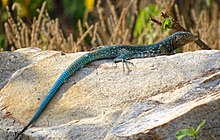Racing lizards
| Racing lizards | ||||||||||||
|---|---|---|---|---|---|---|---|---|---|---|---|---|

|
||||||||||||
| Systematics | ||||||||||||
|
||||||||||||
| Scientific name | ||||||||||||
| Cnemidophorus | ||||||||||||
| Wagler , 1830 |
The racing lizards ( Cnemidophorus ) are a genus of small to medium-sized lizards from the South and Central American family of rail lizards (Teiidae). Besides these, the members belonging to the same family and very closely related genus Aspidoscelis as cnemidophorus called, in the English language as "whiptail lizards" or "race runners".
features
Cnemidophorus species are small to medium-sized, often relatively colorful lizards and reach head-trunk lengths of 10 to a maximum of 15.9 cm ( Cnemidophorus murinus ). Your pupils are kidney-shaped. The teeth in the rear upper jaw and lower jaw are three-pointed and laterally flattened. Cnemidophorus species are the only splint lizards in which the males have a single pair of preanal spores and the (proximal) section of the hemipenis towards the trunk is covered with short papillae. Females of the genus can be distinguished from all other rail lizards by the combination of the following features: The first supraciliaria (part of the scaling of the head) are long with straight ventral margins, the nostrils are almost triangular to approximately round, five regular parietals ( scaling of the apex), smooth ventralia ("Belly scales") and continuous rows of sawn scales on all five toes.
parthenogenesis
Similar to the better known North American Aspidoscelis species (before 2002 also included in Cnemidophorus ), Cnemidophorus s. st. Populations and species detected that consist only of females, i.e. H. to parthenogenesis to reproduce. More closely examined individuals were found to be genetically identical clones . The populations were also recognized as hybridogenic in origin, i.e. they go back to the crossing of two closely related species whose offspring now reproduce asexually. These hybrid lines have been described as new species. Thus, the line was hybridogene Cnemidophorus lemniscatus x Cnemidophorus gramivagus as Art Cnemidophorus Cryptus described . Another population even turned out to be triploid , it obviously goes back to the backcrossing of this hybrid with a parent species ( C. lemniscatus ). The population widespread in Suriname and Guyana was named as the species Cnemidophorus pseudolemniscatus .
Way of life
As far as is known, all species live in open or semi-open habitats, for example savannahs, sandy river banks, but also forest clearings, clearcuts or cultivated land due to human impact; they penetrate along roads into such habitats in previously closed forest landscapes. It is assumed that the shady interior of the forest is not sufficient for their high need for warmth. In northern South America, species of the genus may be some of the most common lizards in open habitats like savannahs. The diet is relatively unspecialized and includes ants, termites, grasshoppers and other arthropods, as well as fruits.
species
The Reptile Database currently lists (February 2014) 18 species belonging to the genus Cnemidophorus . Numerous species previously included here have been identified since the revision by Harvey et al. assigned to other genera such as Aspidoscelis or Ameivula . They are used in Harvey et al. assigned to four morphologically distinguishable groups.
-
Cnemidophorus lemniscatus group; Central America, Northern and Central South America, Trinidad , Tobago , Aruba , San Andrés , Santa Catalina and Providencia .
- Cnemidophorus arenivagus Markezich, Cole & Dessauer, 1997
- Cnemidophorus arubensis Lidth De Jeude, 1887
- Cnemidophorus cryptus Cole & Dessauer, 1993
- Cnemidophorus duellmani Mccranie & Hedges, 2013
- Cnemidophorus flavissimus Ugueto, Harvey & Rivas, 2010
- Cnemidophorus gramivagus Mccrystal & Dixon, 1987
- Spotted lizard ( Cnemidophorus lemniscatus (Linnaeus, 1758))
- Cnemidophorus martyris Stejneger, 1891
- Cnemidophorus pseudolemniscatus Cole & Dessauer, 1993
- Cnemidophorus pyrrhogularis Basto Da Silva & Ávila-Pires, 2013
- Cnemidophorus ruatanus Barbour, 1928
- Cnemidophorus senectus Ugueto, Harvey & Rivas, 2010
-
Cnemidophorus murinus group; Curaçao , Klein Curaçao , Bonaire and Klein Bonaire .
- Cnemidophorus murinus (Laurenti, 1768)
- Cnemidophorus ruthveni Burt, 1935
-
Cnemidophorus nigricolor group; Venezuelan Antilles ( Las Aves , Los Roques , La Orchila , La Blanquilla and Los Hermanos ) and La Tortuga .
- Cnemidophorus leucopsammus Ugueto & Harvey, 2010
- Cnemidophorus nigricolor Peters, 1873
- Cnemidophorus rostralis Ugueto & Harvey, 2010
-
Cnemidophorus vanzoi group; Maria Islands (two small islands southeast of St. Lucia ).
- Cnemidophorus vanzoi (Baskin & Williams, 1966)
literature
- Tod W. Reeder, Herbert C. Dessauer and Charles J. Cole: Phylogenetic relationships of whiptail lizards of the genus Cnemidophorus (Squamata, Teiidae): a test of monophyly, reevaluation of karyotypic evolution, and review of hybrid origins . American Museum novitates 2002. No. 3365: 1-61.
Web links
Individual evidence
- ↑ Charles J. Cole, Herbert C. Dessauer: Unisexual and Bisexual Whiptail Lizards of the Cnemidophorus lemniscatus Complex (Squamata: Teiidae) of the Guiana Region, South America, with Descriptions of New Species (= American Museum Novitates. No. 3081, ISSN 0003-0082 ). American Museum of Natural History, New York NY 1993, online .
- ↑ Laurie J. Vitt, Peter A. Zani, Janalee P. Caldwell, M. Carmozina de Araújo, William E. Magnusson: Ecology of Whiptail Lizards (Cnemidophorus) in the Amazon Region of Brazil. In: Copeia. Vol. 1997, No. 4, 1997, pp. 745-757, doi : 10.2307 / 1447292 .
- ^ Daniel Oliveira Mesquita, Guarino Rinaldi Colli: Geographical Variation in the Ecology of Populations of Some Brazilian Species of Cnemidophorus (Squamata, Teiidae). In: Copeia. Vol. 2003, No. 2, 2003, pp. 285-298, JSTOR 1448670 .
- ↑ Michael B. Harvey, Gabriel N. Ugueto, Ronald N. Gutberlet Jr .: Review of Teiid Morphology with a Revised Taxonomy and Phylogeny of the Teiidae (Lepidosauria: Squamata) (= Zootaxa. 3459). Magnolia Press, Auckland 2012, doi : 10.11646 / zootaxa.3722.3.1 .


